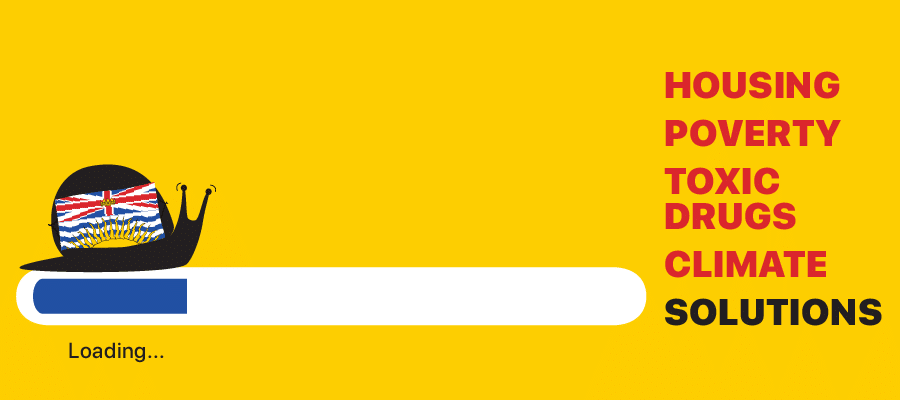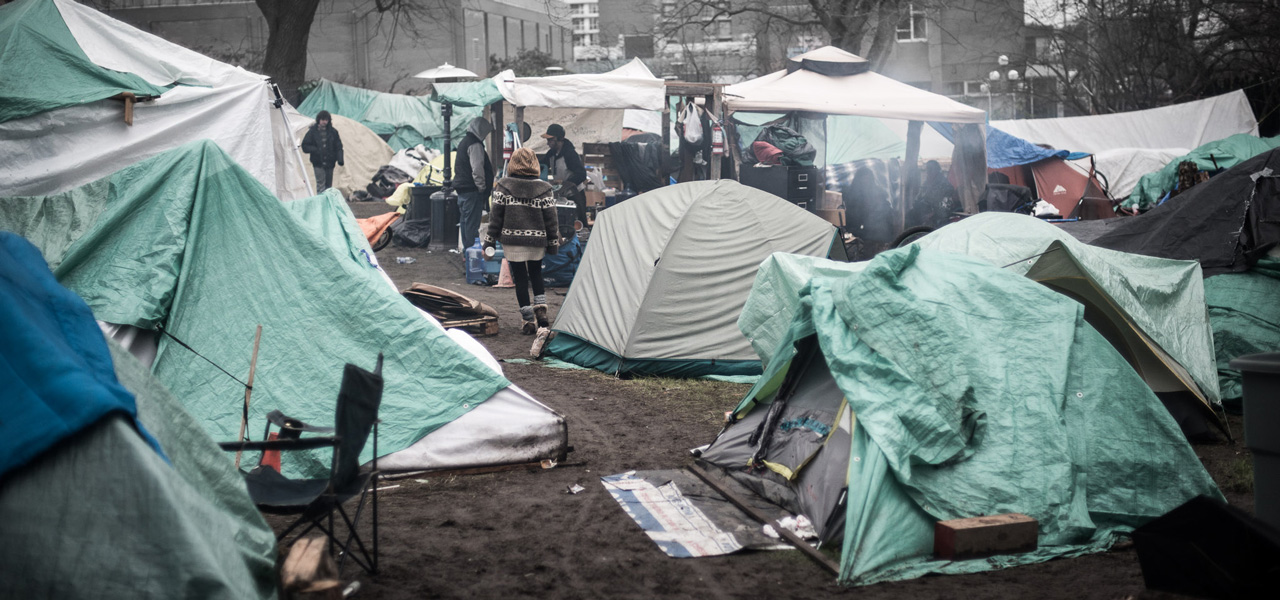BC budget moves in the right direction but too slowly to address pressing challenges like housing, climate, toxic drug supply and poverty

With COVID centre stage for the past two years, Budget 2022 marked a shift back to normal. Yes, the budget earmarks $2 billion in contingencies for potential COVID needs, but this took up a mere half page of the main budget document. The budget narrative instead is framed around child care, climate change and investments in people.
Child care is perhaps the biggest winner with spending increasing from $800 million in 2021/22 to $1.2 billion in 2022/23 and $1.56 billion the year after. Average costs for parents will also drop to about $20 per day, with the government still committed to the goal of $10 per day child care. These investments are largely due to new federal funding on the table with only a modest bump in BC government funding. (Hat tip to the Coalition of Child Care Advocates who deserve special credit after decades of advocacy.)
In the other areas where BC faces major challenges—housing, toxic drugs, climate and poverty—there is some movement in the right direction but much too slowly. Overall budget expenditures are projected to grow by a modest 4.7%. Much of this is in the major areas of health care and education, which account for 60% of expenditures although for the most part these increases merely keep up with rising costs.
It’s worth noting what did not make the cut. No renters’ rebate, no large investments in housing, no safe drug supply, no increase in welfare rates, no major acceleration of climate action.
In areas where BC faces major challenges there is some movement in the right direction but much too slowly.
This is a shame because the fiscal capacity is clearly there. But instead of meeting these pressing needs, the government pads its forecasts with low-balled economic growth and revenues, and various contingency funds. As a result, Budget 2022 limits itself to the point that the big numbers on the projected deficit and revenues cannot even be taken seriously.
A mere 10 months ago, a $10 billion deficit was tabled for 2021/22. That deficit number has been steadily lowered and as of the budget was listed at just under a $500 million deficit. With a forecast allowance of $1 billion and other funds in contingencies, it is almost guaranteed that when the final numbers are in, the 2021/22 fiscal year will close with a large surplus.
To be fair, BC’s economy grew by 12.4% in 2021, a number that reflects the economic bounce back from 2020 and a surge of inflation. This was not anticipated a year ago, in particular the frenzy around real estate. Indeed, property transfer tax revenues swelled to $3.25 billion in 2021/22 from $2.1 billion the year before.
Nonetheless, this incredible turnaround makes one question the fiscal framework for 2022/23, which projects a $5.5 billion deficit but is similarly padded with contingencies, forecast allowances and lowballed projections. The budget projects that revenues will fall in 2022/23 by almost $2 billion, a drop that could only be expected in the event of a recession.
Instead of meeting these pressing needs, the government pads its forecasts with low-balled economic growth and revenues and various contingency funds.
Contingencies have always been in the budget, but with COVID they became a major line item as money notionally allocated to be spent if needed. Budget 2022 sets aside almost $5 billion, nearly 7% of total expenditures, as contingencies for COVID, extreme weather disasters, public sector bargaining, and other unforeseen costs or “priority initiatives.”
There will always be pressure to not spend these full contingency amounts in order to boost the bottom line by year end. This pushes other priorities off the table entirely even though they are well within the fiscal means of the BC government. The end result is a budget that continues to be too timid in making the major investments needed to face urgent challenges.
In spite of two years of pandemic response, BC’s finances are healthy and there is plenty of room for additional investment, if it was prioritized. Provincial debt-to-GDP remains among the lowest of the provinces at 20%, with annual interest costs of only three cents per dollar of revenue.
Housing
On housing, the budget seems to have forgotten the 2018 promise to spend $6.2 billion over 10 years to build new dedicated affordable housing. Only one-third of that amount has been committed so far, although some important investments have been made for modular and supportive housing for people experiencing homelessness and other vulnerable people.
The government appears to be targeting its (unnecessarily low) spending on the most marginalized, including those experiencing homelessness. Budget 2022 includes ongoing support for 3,000 people temporarily housed during COVID in leased hotels and other spaces. Complex care housing, a new twist on supportive housing that provides more intensive health and social supports, will get $164 million over three years. The budget adds $35 million over three years to support youth aging out of care, including up to $600 per month rent supplements. This reflects a key recommendation from the government’s Basic Income panel that reported two years ago.
The government should not be let off the hook for largely abdicating its role in delivering dedicated affordable rental housing for low- to middle-income households. The 114,000 units promised back in the 2017 election are not even close to being fully funded.
The government should not be let off the hook for largely abdicating its role in delivering dedicated affordable rental housing for low- to middle-income households.
For example, a 2021 call for proposals to build social housing received applications for 13,000 new units of housing but only 2,600 were approved due to funding constraints. Budget 2022 increases by a modest $100 million that will add about 850 units of housing. Again, a step in the right direction but a relatively small one.
Housing assets can pay for themselves over time through the rents received so there’s no reason for the government not to build. Instead, the province has favoured low-interest loans, which can play a supportive role but are not the same as direct expenditures. Part of the appeal may be that these loans don’t show up on the budget books as expenditures.
Doing nothing can also look like a move backwards. Amid high inflation there is no increase in welfare rates. Budget 2021 notably increased welfare rates for people on disability assistance, but last year’s gains will be wiped out by rising costs. That the government can continue to endorse a shelter allowance of $375 per month shows the extent of the disconnect.
Climate change
The costs of climate change are front and centre in Budget 2022. For the 2021/22 year, BC had budgeted $200 million for various emergency measures, but then spent an additional $522 million on disaster and emergency assistance related to the November floods and $665 million fighting the summer wildfires.
The full public costs of rebuilding highways and infrastructure or reinforcing dykes arising from 2021’s extreme weather disasters are not fully apparent in the budget. However, there is a $400 million commitment in 2022/23 for flood recovery and another $1.1 billion over three years in contingencies for flood recovery. A promised $5 billion in federal funding to be put toward recovery is mentioned but is not a line item in the budget (perhaps because that funding has not been officially received).
Climate change adaptation, for the first time, is a key part of the budget with $600 million over four years for prevention and preparedness. For wildfires, there is a notable rhetorical shift towards prevention and a more proactive approach. Yet, the budget allocates just under $200 million for firefighting when average costs over the past decade have been $300 million per year.
As for reducing BC’s greenhouse gas emissions, the budget does not adequately fund last October’s CleanBC Roadmap to 2030. At a high level, the CleanBC plan gets $1.2 billion over three years but more than half of this amount is in 2024/25. A big chunk, $250 million over three years, goes to rebates for zero-emission vehicles, a measure that largely benefits already affluent households who would have bought an EV anyway and that reinforces a car-centric society. On the plus side, local governments get $76 million over three years for climate action initiatives. Other funding initiatives are spread very thinly and include some incentives like PST tax credits for heat pumps and used zero emission vehicles.
Climate change adaptation, for the first time, is a key part of the budget.
In the context of a climate emergency, much more could be done and the fiscal room is there. BC will pull in $2.3 billion per year in carbon tax in 2022/23 and another $1 billion in fuel tax. These are much larger than what the province will spend on CleanBC. Increases in the carbon tax as per federal proposed increase to $170 per tonne are not in the fiscal plan.
In a related area, the province’s review of the oil and gas royalty regime does not figure in the budget, although changes are expected in the near future to modernize the regime and reduce fossil fuel subsidies. Nonetheless, the budget anticipates $2.1 billion in fossil fuel subsidies over three years, of which $1.8 billion reflect deep drilling credits associated with fracking.
In the area of capital spending there will be $2 billion towards transit investments over the fiscal plan (the Broadway and Surrey-Langely Skytrain lines). But this is less than one-third of total transportation capital spending, with most going toward highways and car infrastructure.
And while not directly climate-related, the budget provides $185 million in just transition funding to support workers and communities affected by deferrals of old growth logging. This important commitment includes a Bridging to Retirement Fund, providing up to $75,000 in transition funding for older workers over 55. This could serve up some lessons for the just transition that will be needed in the oil and gas sector.
It’s hard to place too much blame on a government that is doing the right things, but at far too slow a pace. Over the decades there have been many savage budgets in terms of neglect and outright cuts. And there are pockets of hope, like the $30 million for non-profits that have been adversely affected by COVID and a new Declaration Act Secretariat aimed at spurring reconciliation with Indigenous people. Still, in terms of the big challenges our province faces, this budget is another lost opportunity to make a meaningful dent, even though this government has a clear mandate to act on those challenges.
Topics: Climate change & energy policy, Housing & homelessness, Provincial budget & finance



